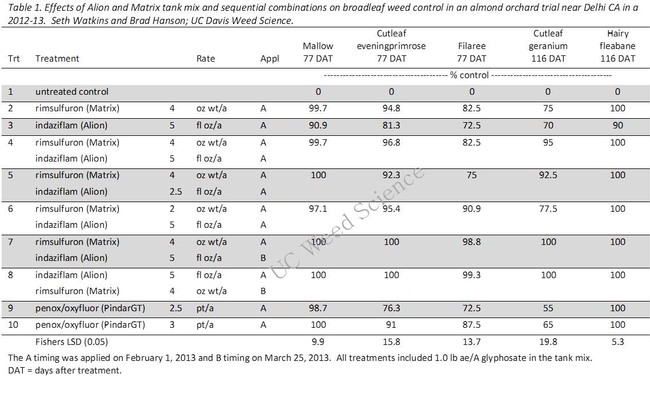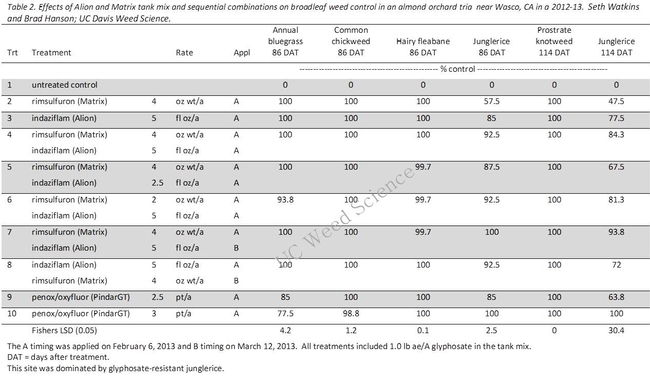Repost from UCWeedScience blog
One of the major research and extension areas in my program is weed control efficacy in orchards and vineyards. During the 2012-13 growing season, we conducted about 50 herbicide efficacy trials in commercial orchards or research station sites. Today I thought I’d share some data from 2012-13 orchard weed control efficacy experiments comparing various tank mixtures and sequential applications of Matrix (rimsulfuron) and Alion (indaziflam). This work was primarily funded by the Almond Board of California, Bayer CropSciences, and DuPont.
By way of background, both of these herbicides are residual products with different modes of action. Matrix is a group 2 herbide (ALS inhibitor) and Alion is a group 29 herbicide (cellulose biosynthesis inhibitor). They are both good herbicides, but like any herbicide, can have weaknesses on certain weeds or under certain conditions. Some folks have started recommending one over the other or mixing the two together in various ratios. So, we decided to evaluate various full- and half-rate comparisons in two almond orchard trials to see how they compared. We also included another residual product, Pindar GT (penoxsulam plus oxyfluorfen), for comparison purposes.
At the Delhi site, which had a mixed bag of broadleaf species, the treatments were applied February 1st and March 25, 2013. At the Wasco site, the treatments were applied February 6 and March 12, 2013. Our small-plot trials like these are applied with callibrated backpack spray equipment in plot that are usually about 8 ft by 30 ft and replicated 4 times at each site.
As might be expected, tank mixes and sequential applications usually were better than either product alone on the mixed weed population at the Delhi site (Table 1). All the treatments performed well on mallow. On eveningprimrose and filaree, the full rate treatments and the sequential treatments (with an extra shot of glyphosate) were a bit better than the others by 77 DAT. By 116 DAT, both sequential applications (with glyphosate) still had nearly perfect weed control. The Alion and Matrix combinations were better than the solo products and better than Pindar GT on the tough weed cutleaf geranium. Hairy fleabane control was near perfect with all treatments except Alion by itself which still had 90% control 116 DAT.
The Wasco site, which was dominated by glyphosate-resistant junglerice during the summer, also had good control of annual bluegrass and common chickweed during the winter with all Alion and Matrix treatments (Table 2). Junglerice control both 86 and 114 DAT was better with Alion than Matrix alone, and the combinations tended to be have better control. For the most part, Alion was a little better than Matrix for residual cotnrol of junglerice in this study. Also, when applied sequentially, Alion following Matrix (trt 7) was better than Matrix following Alion (trt 8), probably due to longer persistence of that herbicide into the summer season (warm and wet soils).
I’ll be sharing a few more of these data over the next few weeks in blog posts. Also, we’ll be discussing some of these findings through the fall and winter at UC Cooperative Extension meetings and other extension opportunities. See you there.
Click here for other recent orchard and vineyard weed control blog posts at the UCWeedScience blog
Take care,
Brad




Andre Tolmachoff
October 2, 2013Great post! Last winter we sprayed Alion on a almond orchard and Matrix on a different almond ranch. Both products worked very well, we were pleasantly surprised. However, is there a possibility that these products kill bare root replants in mature orchards? Think the label indicates spraying in orchards older than three year though, every orchard has replants.
Thank You
Brand Hanson
October 2, 2013Hi Andre,
The labels for both Alion and Matrix indicate “apply to trees that have been established for a minimum of one year”. While it is unlikely that replants would be killed outright by these herbicide (under normal circumstances), it certainly is possible that injury or stunting could occur to new transplants. There is very little “inherent” tolerance of trees to most of our herbicides – crop safety is usually more of a function of placement (below the foliage, but not into the tree root zone). So, young trees with small root systems will almost always have a greater chance of injury no matter the herbicide – that’s why the labels contain those qualifiers.
So, what do you do in real life? Cartons will help with the chance of trunk and crown exposure to some degree. Irrigation management is also important – water applied shortly after the application will account for the majority of herbicide movement into the profile (esp. in sandy or gravelly soil). A little bit of water within a week or so will help “set” the herbicide but a lot of water could increase the probability of pushing into the root zone of a small tree. To be even safer, an applicator should try to turn the sprayer off/on right around the new trees – a foot or two would increase the safety greatly.
Realistically, if I had a large number of replants, I’d consider treating the orchard more like a new orchard. If I had a “normal” number of replants, I’d install cartons, use low-label rates, not apply a deep irrigation on newly treated strips, and recognize that that the new trees face a lot of potential stresses including my weed control program.
Brad